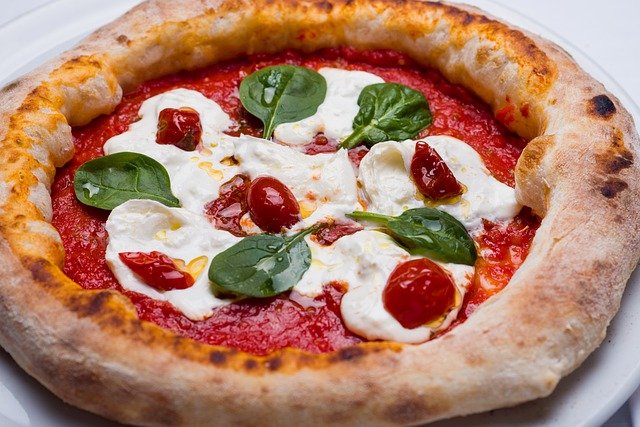There is no doubt that pizza is the world’s favourite fast food. But how exactly did this humble street food come to enjoy such global domination? Read our short history of pizza to find out…
On a trip to Naples in 1831, Samuel Morse – the inventor of the groundbreaking Morse Code – described pizza as ‘a species of most nauseating cake…it all together looks like a piece of bread that has been taken reeking out of the sewer.’
Nearly 200 years later, and with annual global pizza sales estimated at $150 billion, it would appear that his unflattering critique may have been somewhat premature.
The stuff of legend
The history of pizza dates back as far as Ancient Greece. We can find an early reference to ‘pizza’ in the Aeneid in 19BC:
After the fall of Troy, a plucky band of survivors set sail for Italy to start a new life. During the voyage, a swarm of Harpies (fierce bird-like creatures with beautiful faces) attack the ship. The Harpy queen places a curse on them, promising that ‘they will never build a new city until hunger forces them to eat their own tables.’
Several days later, they enjoy a meal of fruits and vegetables spread out over hard, round loaves. Having finished the ‘toppings’, they are still hungry and proceed to devour the loaves. One of the men jokes that they have eaten their ‘tables.’ Not only had the men invented the first ‘pizzas’, they had also lifted the curse!
(although the topping first – base second’ technique never really caught on!)
Several centuries later, the ancient Greeks would often serve a flatbread called plakous. This was focaccia like bread topped with a combination of herbs, garlic, and cheeses.

In 6BC, warriors in the Persian found a novel use for their shields. When not engaged in battle, they would turn their shields horizontal and use the hot surface for baking cheese and date flatbreads.
Little did they know it, but these ancient civilizations were all laying the groundwork for the pizza we enjoy today.
The first pizza delivery
Somewhat surprisingly, the first recorded use of the word pizza actually coincides with the first recorded pizza delivery order.
It was placed in AD 997 and delivered to the Bishop of Gatea, a small village 60 miles north of Naples.
The order was for ‘duodecim pizze,’ or twelve pizzas, every Christmas day and a further twelve every Easter Sunday.
History does not reveal if the Bishop requested toppings. However, we know that ‘shoulder pork and kidney…and a couple of chickens’ were ordered on the side!

The arrival of the tomato
No doubt he bishop and his guests enjoyed their pizzas. However, today’s pizza enthusiast may have felt a little differently.
At this point in history, pizzas were still essentially flatbreads topped with mixed herbs and olive oil. A little more reminiscent of garlic bread than an Americano.
This was because pizza’s defining ingredient – the noble tomato – did not arrive in Italy from the Americas until 1548.
Nowadays, it is difficult to imagine an Italian meal without the ‘pomodoro’. However, it took a little time for this iconic ingredient to catch on.

Their bright red colour earned them the nickname ‘the devil’s fruit’, and many assumed them to be poisonous.
Amazingkly, they were generally used as a decoration!
It was not until a couple of centuries later that they started regularly featuring on the menu.
18th century Naples

The next significant development in the history of pizza happened in Naples itself.
In the late 1700s, Naples was a bustling city on the sea. Ships laden with cargo sailed daily into the port, unloading exotic cargo from faraway shores. Employment opportunities were plentiful in the Bay of Naples, and hundreds of dwellings sprung up around the harbour to accommodate the many new dock workers. Most of these were basic, one-room dwellings without cooking facilities.
Work on docks was intense and back-breaking labour, and there wasn’t much staff food on offer either!
These workers existed mainly on street food, and often they had to eat on the job. So, they looked for food that was cheap, filling, and most of all, portable.
Spotting this emerging market, a group of entrepreneurial street vendors, or ‘pizzaiolos’, set up stalls around the harbour edge. They sold pizza by the slice to the dockworkers and made a very tidy profit.
The Margherita
1889 Napoli: The streets are adorned with Italian flags. Small children hang, precariously, from high shuttered windows. The port is a buzz of excitement, and locals dress in their Sunday best.
Queen Margherita and King Umbeto I are coming to visit!
Napoli’s master chef, Raffaele Esposito, is charged with creating a signature dish in honour of this auspicious occasion.
After much thought, Esposito comes up with a dish as experimental as it was patriotic. A pizza emblazoned with the colours of the national flag. He achieved this by topping his pizza with tomato paste, fresh green basil, and mozzarella cheese. Although this dish was a far cry from the haute cuisine that usually graced the royal table, he hoped that his unique take on local street food would impress.
He named his pizza ‘the Margherita’ in honour of the queen.

The queen loved the pizza and, on returning from her trip, penned a hand-written note to the chef to tell him how much she had enjoyed it.
Over a century and a half later, Esposito’s pizzeria is still operating in Naples, and the letter is proudly displayed for all to see.
The migration of the pizza
Large numbers of Italians migrated to the United States in the 19th and 20th century, and they brought their local food traditions with them.
In 1905, an Italian ex-pat, Gennari Lombardi, began selling homemade pizza pies in his grocery shop in New York. They became so popular with the locals that Gennari eventually decided to convert his entire shop into a restaurant. And thus, America’s first pizzeria was born.
While Lombardi was very successful in selling his pizzas to local New Yorkers, it wasn’t until after the end of the second world war that pizza really took America by storm. Soldiers returning from Italian battlefields had experienced pizza during their time overseas and now wanted to enjoy a slice or two at home.
Shortly after that, Pizza Hut and Domino’s began to appear in towns across the USA.
The rest, as they say, is history.
